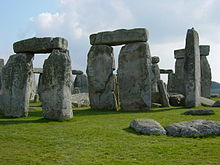
Back بريطانيا ما قبل التاريخ Arabic Гісторыя Старажытнай Брытаніі Byelorussian Праисторическа Британия Bulgarian Gran Bretanya prehistòrica Catalan Dějiny prehistorické Británie Czech Vorgeschichte Großbritanniens German Gran Bretaña prehistórica Spanish بریتانیای پیشاتاریخ Persian Britannian esihistoria Finnish Préhistoire de la Grande-Bretagne French
This article has multiple issues. Please help improve it or discuss these issues on the talk page. (Learn how and when to remove these messages)
|
| History of the British Isles |
|---|
 |
Several species of humans have intermittently occupied Great Britain for almost a million years. The earliest evidence of human occupation around 900,000 years ago is at Happisburgh on the Norfolk coast, with stone tools and footprints probably made by Homo antecessor. The oldest human fossils, around 500,000 years old, are of Homo heidelbergensis at Boxgrove in Sussex. Until this time Britain had been permanently connected to the Continent by a chalk ridge between South East England and northern France called the Weald-Artois Anticline, but during the Anglian Glaciation around 425,000 years ago a megaflood broke through the ridge, and Britain became an island when sea levels rose during the following Hoxnian interglacial.
Fossils of very early Neanderthals dating to around 400,000 years ago have been found at Swanscombe in Kent, and of classic Neanderthals about 225,000 years old at Pontnewydd in Wales. Britain was unoccupied by humans between 180,000 and 60,000 years ago, when Neanderthals returned. By 40,000 years ago they had become extinct and modern humans had reached Britain. But even their occupations were brief and intermittent due to a climate which swung between low temperatures with a tundra habitat and severe ice ages which made Britain uninhabitable for long periods. The last of these, the Younger Dryas, ended around 11,700 years ago, and since then Britain has been continuously occupied.
Traditionally it was claimed by academics that a post-glacial land bridge existed between Britain and Ireland, however this conjecture began to be refuted by a consensus within the academic community starting in 1983, and since 2006 the idea of a land bridge has been disproven based upon conclusive marine geological evidence. It is now concluded that an ice bridge existed between Britain and Ireland up until 16,000 years ago, but this had melted by around 14,000 years ago.[1][2] Britain was at this time still joined to the Continent by a land bridge known as Doggerland, but due to rising sea levels this causeway of dry land would have become a series of estuaries, inlets and islands by 7000 BC,[3] and by 6200 BC, it would have become completely submerged.[4][5]
Located at the fringes of Europe, Britain received European technological and cultural developments much later than Southern Europe and the Mediterranean region did during prehistory. By around 4000 BC, the island was populated by people with a Neolithic culture. This neolithic population had significant ancestry from the earliest farming communities in Anatolia, indicating that a major migration accompanied farming. The beginning of the Bronze Age and the Bell Beaker culture was marked by an even greater population turnover, this time displacing more than 90% of Britain's neolithic ancestry in the process. This is documented by recent ancient DNA studies which demonstrate that the immigrants had large amounts of Bronze-Age Eurasian Steppe ancestry, associated with the spread of Indo-European languages and the Yamnaya culture.[6]
No written language of the pre-Roman inhabitants of Britain is known; therefore, the history, culture and way of life of pre-Roman Britain are known mainly through archaeological finds. Archaeological evidence demonstrates that ancient Britons were involved in extensive maritime trade and cultural links with the rest of Europe from the Neolithic onwards, especially by exporting tin that was in abundant supply. Although the main evidence for the period is archaeological, available genetic evidence is increasing, and views of British prehistory are evolving accordingly. Julius Caesar's first invasion of Britain in 55 BC is regarded as the start of recorded protohistory although some historical information is available from before then.[7]
- ^ Edwards, R.J., Brooks, A.J (2008). "The Island of Ireland: Drowning the Myth of an Irish Land-bridge?". The Irish Naturalists' Journal: 19–34. Retrieved 3 April 2022.
{{cite journal}}: CS1 maint: multiple names: authors list (link) - ^ Joseph T. Kelley, J. Andrew G. Cooper, Derek W.T. Jackson,Daniel F. Belknap, Rory J. Quinn (2006). "Sea-level change and inner shelf stratigraphy off Northern Ireland". Marine Geology. 232 (1–2): 1–15. Bibcode:2006MGeol.232....1K. doi:10.1016/j.margeo.2006.04.002. S2CID 128396341. Retrieved 3 April 2022.
{{cite journal}}: CS1 maint: multiple names: authors list (link) - ^ J. Walker, V. Gaffney, S. Fitch, M. Muru, A. Fraser, M. Bates and R. Bates (2020). "A great wave: the Storegga tsunami and the end of Doggerland?". Antiquity. 94 (378): 1409–1425. doi:10.15184/aqy.2020.49. hdl:10454/18239. S2CID 229168218.
{{cite journal}}: CS1 maint: multiple names: authors list (link) - ^ Nora McGreevy (2020). "Study Rewrites History of Ancient Land Bridge Between Britain and Europe". Smithsonian Magazine. Retrieved 3 April 2022.
- ^ Cunliffe, 2012, pp. 47–56
- ^ Cite error: The named reference
autogenerated1was invoked but never defined (see the help page). - ^ The 4th-century BC account by Pytheas has not survived, and only brief pieces of it are known from other writers.